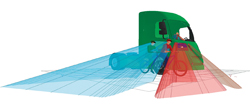 A longer, more aerodynamic cab with better vision for truck drivers could save the lives of hundreds of cyclists and pedestrians, according to a new study by academics at Loughborough University’s Design School.
A longer, more aerodynamic cab with better vision for truck drivers could save the lives of hundreds of cyclists and pedestrians, according to a new study by academics at Loughborough University’s Design School.
The proposed new cab, 80 cm longer with a rounded nose, smaller dashboard, expanded glazed areas and a slightly lower driver position would drastically reduce blindspots around the truck, researchers said. The Design School claimed the ‘Direct Vision’ truck concept would increase the driver’s field of view in front and to the sides of the vehicle by 50 per cent compared to current truck designs.
The study was conducted by Dr Steve Summerskill and Dr Russell Marshall from the Loughborough Design School, and was commissioned by Transport for London (TfL) and Transport & Environment (T&E).
“Blindspots can be a significant factor in fatal accidents,” said Dr Summerskill, project lead of the ‘Direct Vision’ concept. “The study shows the size of these blindspots can be minimised through improved cab design, the reduction of cab height and the addition of extra windows.”
William Todts, senior policy officer at T&E, said it was imperative politicians backed the proposals.
“It’s incomprehensible that we allow huge 40-tonne mammoths on our roads without making sure the people behind the wheel can actually see what’s going on,” he said. “After decades of tinkering with mirrors, we need to take this once-in-a-generation opportunity and make direct vision compulsory for new lorry designs.”
The study analysed 704 accidents involving HGVs and found 31 per cent of road fatalities were caused by drivers pulling away, 19 per cent were caused by left turns, seven per cent by right turns, and 25 per cent from drivers reversing.
The analysis indicated ‘critical blindspots’ in current trucks cannot be compensated for by the use of a driver’s mirrors, because of the time lapse between checking them, making observations through the window, and then pulling away from a junction. “If this time period is four seconds, this is enough time for a cyclist to undertake the HGV, with the driver being unaware of his or her presence,” the paper said.






